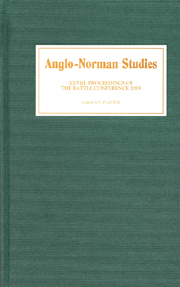Book contents
- Frontmatter
- Contents
- LIST OF ILLUSTRATIONS, MAPS, AND TABLES
- EDITOR'S PREFACE
- ABBREVIATIONS
- Inside the Anglo-Norman Family: Love, Marriage, and the Family (R. Allen Brown Memorial Lecture)
- Land Tenure and Royal Patronage in the Early English Kingdom: A Model and a Case Study
- The Homilies of a Pragmatic Archbishop's Handbook in Context: Cotton Tiberius A. iii
- Robert de Vaux and Roger de Stuteville, Sheriffs of Cumberland and Northumberland, 1170–1185
- The Common Steeple? Church, Liturgy, and Settlement in Early Medieval Lincolnshire
- The Question of Masculinity in William of Malmesbury's Presentation of Wulfstan of Worcester
- Share and Share Alike? Bishops and their Cathedral Chapters: The Domesday Evidence
- Dunstan and Monastic Reform: Tenth-Century Fact or Twelfth-Century Fiction?
- Domesday Now
Land Tenure and Royal Patronage in the Early English Kingdom: A Model and a Case Study
Published online by Cambridge University Press: 12 September 2012
- Frontmatter
- Contents
- LIST OF ILLUSTRATIONS, MAPS, AND TABLES
- EDITOR'S PREFACE
- ABBREVIATIONS
- Inside the Anglo-Norman Family: Love, Marriage, and the Family (R. Allen Brown Memorial Lecture)
- Land Tenure and Royal Patronage in the Early English Kingdom: A Model and a Case Study
- The Homilies of a Pragmatic Archbishop's Handbook in Context: Cotton Tiberius A. iii
- Robert de Vaux and Roger de Stuteville, Sheriffs of Cumberland and Northumberland, 1170–1185
- The Common Steeple? Church, Liturgy, and Settlement in Early Medieval Lincolnshire
- The Question of Masculinity in William of Malmesbury's Presentation of Wulfstan of Worcester
- Share and Share Alike? Bishops and their Cathedral Chapters: The Domesday Evidence
- Dunstan and Monastic Reform: Tenth-Century Fact or Twelfth-Century Fiction?
- Domesday Now
Summary
King Alfred's version of St Augustine's Soliloquies contains a famous allusion to the process of tenurial patronage:
Every man likes, when he has built up a farm on his lord's lease with his help, to stay there some time … and to work for himself on the lease both on sea and on land, until the time when he shall earn bookland and eternal inheritance through his lord's kindness.
This paper is concerned with the various forms of patronage to which Alfred alludes: bookland, land which was not bookland, and leased land (Old English lænland). Its argument comes in two halves. The first half sketches a model of land tenure in late Anglo-Saxon England which stresses the importance of land leased to royal officials on an ex officio basis for the duration of their period in office, and offers a corrective to the view, implicit in much of the literature, that grants by royal diploma were the principal instrument of royal patronage in late Anglo-Saxon England. The second half uses a case study of Bampton hundred in Oxfordshire in the tenth and eleventh centuries to illustrate some of the points made in the first. Bampton hundred has been selected because it affords remarkably clear evidence that late Anglo-Saxon kings could exercise patronage in various ways, for numerous beneficiaries, in a powerful and well co-ordinated manner. It also supplies an unusually well documented example of one of the most important developments in the tenurial structure of late Anglo-Saxon England: the process of manorial fission which caused large tenurial units to fragment into much smaller units of lordship.
- Type
- Chapter
- Information
- Anglo-Norman Studies 28Proceedings of the Battle Conference 2005, pp. 19 - 46Publisher: Boydell & BrewerPrint publication year: 2006

